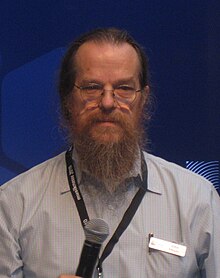
John Meyer is a pioneer in the sound reinforcement industry. In 1979 he founded Meyer Sound Laboratories with his wife, Helen Meyer.

John Meyer is a pioneer in the sound reinforcement industry. In 1979 he founded Meyer Sound Laboratories with his wife, Helen Meyer.
John Meyer grew up in Berkeley, California. His earliest involvement with audio was in the late 1950s at the radio station KPFA. He received a radiotelephone third class license at 12 years old, and a second class license when he was 15. [1] He attended Oakland High which was one of the first schools in the country to have an audio department. In the audio department he would build consoles and other audio devices [2]
John Meyer started his career in 1967 working in a Berkeley hi-fi store doing custom installs. There he met Steve Miller, who was looking to outfit his band. John Meyer assembled a custom amplification system for The Steve Miller Band when they appeared at the Monterey Pop Festival. [3] John worked with Jim Meagher of Meagher Electronics at the Monterey Pop Festival.
Soon after John Meyer started a company called Glyph to design and build sound reinforcement systems. Glyph's first installation was at a San Rafael club called Pepperland. It was a pure exponential horn-loaded bi-amped quadraphonic sound system. Each stack included a white fiberglass bass, mid-range and hi frequency horns. The bass horns were huge, measuring 8×8 feet with 30-inch drivers. This system was used from 1969 until 1970 when Pepperland closed down. [4]
In 1971 he started working for McCune Sound Service. McCune was interested in building reliable transportable sound systems. While at McCune John first realized his idea of a fully integrated loudspeaker system. The system was built for Creedence Clearwater Revival's last tour. It was a fully integrated tri-amped, horn-loaded system with processing electronics. [5] Three amps were built into a rack-mountable enclosure that would drive two speakers. The enclosure also included preset cross-overs and equalization. The outside of the enclosure was simple: an AC cord, input connectors, and 4-pin connectors that plugged into the loudspeakers. The original model did not have level controls or a power switch. [3]
While at McCune, John Meyer started doing sound reinforcement work with outdoor classical music symphony concerts at Stanford University. This led to an involvement with the Institute of Advanced Music Studies in Montreux, Switzerland which was exploring the idea of building a high-quality sound reinforcement system for classical music. In 1973, he was invited to establish an acoustics lab and perform research at the Institute. One of his primary goals was to research the origins of non-linearity in audio transducers. He spent one and a half years in Switzerland. While there, he designed a modular loudspeaker system and a high-frequency horn driver that led directly to some of the initial innovations at Meyer Sound Laboratories. [4]
During the early 1970s, Meyer was involved with the Grateful Dead, providing them audio advice and performing audio research and experimentation with Don Pearson and Owsley Stanley. [6]
In the 1970s, Meyer met his future wife Helen, a neighbor in Berkeley. John and Helen's first official date was at Thos Tenney, the high-end hi-fi store in Berkeley at which he was working, to listen to Sgt. Pepper's Lonely Hearts Club Band on a pair of Klipschorns. This was Helen's first introduction to quality sound reproduction. [7]
John and Helen founded Meyer Sound Laboratories in 1979 after his return from Switzerland. The company was started in San Leandro, California, and then moved to Berkeley, California.
In 2005, Meyer was made a Fellow of the Audio Engineering Society, and in 2007, he was awarded the organization's Silver Medal. [8]

A subwoofer is a loudspeaker designed to reproduce low-pitched audio frequencies known as bass and sub-bass, lower in frequency than those which can be (optimally) generated by a woofer. The typical frequency range for a subwoofer is about 20–200 Hz for consumer products, below 100 Hz for professional live sound, and below 80 Hz in THX-certified systems. Subwoofers are never used alone, as they are intended to augment the low-frequency range of loudspeakers that cover the higher frequency bands. While the term "subwoofer" technically only refers to the speaker driver, in common parlance, the term often refers to a subwoofer driver mounted in a speaker enclosure (cabinet), often with a built-in amplifier.

A loudspeaker is an electroacoustic transducer that converts an electrical audio signal into a corresponding sound. A speaker system, also often simply referred to as a "speaker" or "loudspeaker", comprises one or more such speaker drivers, an enclosure, and electrical connections possibly including a crossover network. The speaker driver can be viewed as a linear motor attached to a diaphragm which couples that motor's movement to motion of air, that is, sound. An audio signal, typically from a microphone, recording, or radio broadcast, is amplified electronically to a power level capable of driving that motor in order to reproduce the sound corresponding to the original unamplified electronic signal. This is thus the opposite function to the microphone; indeed the dynamic speaker driver, by far the most common type, is a linear motor in the same basic configuration as the dynamic microphone which uses such a motor in reverse, as a generator.
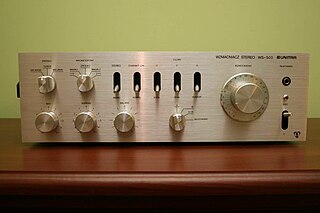
An audio power amplifier is an electronic amplifier that amplifies low-power electronic audio signals, such as the signal from a radio receiver or an electric guitar pickup, to a level that is high enough for driving loudspeakers or headphones. Audio power amplifiers are found in all manner of sound systems including sound reinforcement, public address, home audio systems and musical instrument amplifiers like guitar amplifiers. It is the final electronic stage in a typical audio playback chain before the signal is sent to the loudspeakers.

A sound reinforcement system is the combination of microphones, signal processors, amplifiers, and loudspeakers in enclosures all controlled by a mixing console that makes live or pre-recorded sounds louder and may also distribute those sounds to a larger or more distant audience. In many situations, a sound reinforcement system is also used to enhance or alter the sound of the sources on the stage, typically by using electronic effects, such as reverb, as opposed to simply amplifying the sources unaltered.

A horn loudspeaker is a loudspeaker or loudspeaker element which uses an acoustic horn to increase the overall efficiency of the driving element(s). A common form (right) consists of a compression driver which produces sound waves with a small metal diaphragm vibrated by an electromagnet, attached to a horn, a flaring duct to conduct the sound waves to the open air. Another type is a woofer driver mounted in a loudspeaker enclosure which is divided by internal partitions to form a zigzag flaring duct which functions as a horn; this type is called a folded horn speaker. The horn serves to improve the coupling efficiency between the speaker driver and the air. The horn can be thought of as an "acoustic transformer" that provides impedance matching between the relatively dense diaphragm material and the less-dense air. The result is greater acoustic output power from a given driver.
Celestion is a British designer and exporter of professional loudspeakers.

Powered speakers, also known as self-powered speakers and active speakers, are loudspeakers that have built-in amplifiers. Powered speakers are used in a range of settings, including in sound reinforcement systems, both for the main speakers facing the audience and the monitor speakers facing the performers; by DJs performing at dance events and raves; in private homes as part of hi-fi or home cinema audio systems and as computer speakers. They can be connected directly to a mixing console or other low-level audio signal source without the need for an external amplifier. Some active speakers designed for sound reinforcement system use have an onboard mixing console and microphone preamplifier, which enables microphones to be connected directly to the speaker.
Meagher Electronics was a Monterey, California, company which was founded in 1947 by Jim Meagher. It included a recording studio which recorded early demos for Joan Baez, her sister, Mimi Farina and her sister's husband, Richard Farina. The company also repaired all sorts of home entertainment equipment, focusing on professional and semi professional sound equipment and high end home systems. It had a huge, high warehouse space in which literally hundreds of old wooden console radios and phonographs dating back to the 1920s were stacked to the rafters. Meagher used to explain that these had been left by customers who chose not to pick them up instead of paying the repair estimate charges.
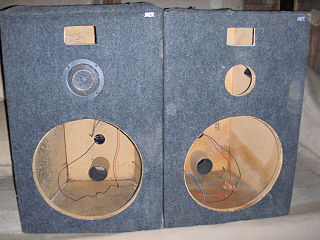
A loudspeaker enclosure or loudspeaker cabinet is an enclosure in which speaker drivers and associated electronic hardware, such as crossover circuits and, in some cases, power amplifiers, are mounted. Enclosures may range in design from simple, homemade DIY rectangular particleboard boxes to very complex, expensive computer-designed hi-fi cabinets that incorporate composite materials, internal baffles, horns, bass reflex ports and acoustic insulation. Loudspeaker enclosures range in size from small "bookshelf" speaker cabinets with 4-inch (10 cm) woofers and small tweeters designed for listening to music with a hi-fi system in a private home to huge, heavy subwoofer enclosures with multiple 18-inch (46 cm) or even 21-inch (53 cm) speakers in huge enclosures which are designed for use in stadium concert sound reinforcement systems for rock music concerts.
Meyer Sound Laboratories is an American company based in Berkeley, California that manufactures self-powered loudspeakers, multichannel audio show control systems, electroacoustic architecture, and audio analysis tools for the professional sound reinforcement, fixed installation, and sound recording industries.
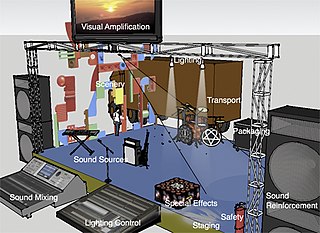
Live event support includes staging, scenery, mechanicals, sound, lighting, video, special effects, transport, packaging, communications, costume and makeup for live performance events including theater, music, dance, and opera. They all share the same goal: to convince live audience members that there is no better place that they could be at the moment. This is achieved through establishing a bond between performer and audience. Live performance events tend to use visual scenery, lighting, costume amplification and a shorter history of visual projection and sound amplification reinforcement.

Yorkville Sound is a Canadian manufacturer of audio amplifiers, loudspeakers and related professional sound reinforcement equipment. Based in Pickering, Ontario, Canada, the firm has a global presence as an importer and exporter of audio electronic products.
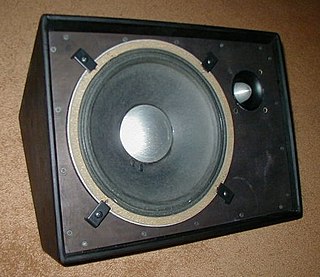
A stage monitor system is a set of performer-facing loudspeakers called monitor speakers, stage monitors, floor monitors, wedges, or foldbacks on stage during live music performances in which a sound reinforcement system is used to amplify a performance for the audience. The monitor system allows musicians to hear themselves and fellow band members clearly.
A parabolic loudspeaker is a loudspeaker which seeks to focus its sound in coherent plane waves either by reflecting sound output from a speaker driver to a parabolic reflector aimed at the target audience, or by arraying drivers on a parabolic surface. The resulting beam of sound travels farther, with less dissipation in air, than horn loudspeakers, and can be more focused than line array loudspeakers allowing sound to be sent to isolated audience targets. The parabolic loudspeaker has been used for such diverse purposes as directing sound at faraway targets in performing arts centers and stadia, for industrial testing, for intimate listening at museum exhibits, and as a sonic weapon.
A coaxial loudspeaker is a loudspeaker system in which the individual driver units radiate sound from the same point or axis. Two general types exist: one is a compact design using two or three speaker drivers, usually in car audio, and the other is a two-way high-power design for professional audio, also known as single-source or dual-concentric loudspeakers. The design is favored for its compactness and behavior as an audio point source.

McCune Audio Video Lighting is an American company based in South San Francisco, California, with offices in Monterey and Anaheim. It is one of the oldest and largest audio visual rental and sound services in the U.S. McCune was founded in 1932 by Harry McCune Sr, McCune AVL provides audio, lighting and high-definition video services to events as varied as outdoor festivals such as the Monterey Jazz Festival, and the Bohemian Grove, and to arena conferences such as TED.
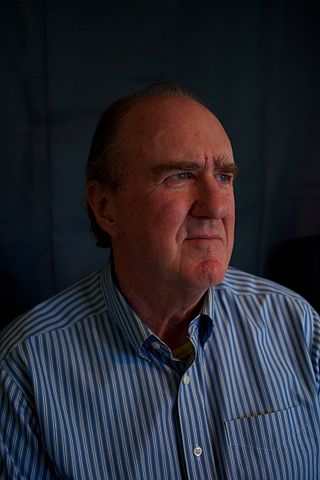
Cliff Henricksen is a musician, inventor and audio technologist. He is self-taught as a musician with a graduate degree in mechanical engineering at Massachusetts Institute of Technology (MIT). Throughout his career Cliff has found innovative ways to apply engineering basics to electro acoustics and to audio technology as it applies to music and in particular to live music performance. He has invented and engineered a wide variety of technologies and products well known in the world of professional audio. Today he balances work in audio and work as a performing musician.

In a loudspeaker, a phase plug, phasing plug or acoustical transformer is a mechanical interface between a speaker driver and the audience. The phase plug extends high frequency response because it guides waves outward toward the listener rather than allowing them to interact destructively near the driver.
Abe John Jacob is an American sound designer and audio engineer. Called the "Godfather of Sound", Jacob greatly influenced the design of sound reinforcement in modern musical theatre, and was one of the first persons credited in the role of sound designer on Broadway, with a sound designer credit in Playbill in 1971.

Robert Vernon Cavin is an American audio engineer who built the first monitor mixing console, the first multi-angle monitor loudspeaker, and the first integrated processing/amplifier package for a 3-way loudspeaker. He was chief engineer of McCune Sound in San Francisco in the 1970s, and also vice president in the 1980s. In 1992 he accepted the chief engineer position at Apogee Sound where he designed the DA Series Class-H digitally controlled amplifier, winning the 1994 TCI Product of the Year Award. In 2000 he joined Furman Sound, and designed an interface system for Smaart users, and a new power conditioning system. Cavin's electronic designs were nominated five times for TEC Awards, in 1994, 1995, 1997, 1999 and 2001.